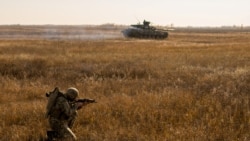Secretary of Defense Lloyd Austin said China's hypersonic missile test over the summer drew "concerns" about Beijing's growing capability, but he said he did not compare it to Russia's launching of the world's first artificial satellite, Sputnik I, in the 1950s.
"Those are terms that I wouldn't use, I don't personally use," Austin replied Wednesday to reporters asking whether the July 27 launch was a "Sputnik moment."
Austin called China the U.S. military's "pacing challenge" but added that the U.S. was focused on "robust capability across the board" rather than one specific capability such as hypersonic weapons.
Even though the Chinese weapon missed its target by several kilometers, according to the Financial Times, the test marked the first time any country had sent a hypersonic weapon fully around the Earth. Hypersonic weapons travel at more than five times the speed of sound and are incredibly difficult to track.
China has denied it carried out a hypersonic missile test, saying it was testing a reusable spacecraft.
In an interview with CBS News that aired this week, General John Hyten, vice chairman of the Joint Chiefs of Staff, struck a more forceful tone when discussing the hypersonic test.
"It's a very significant capability that has the potential to change a lot of things," Hyten said.
Asked if he would compare the Chinese test to Sputnik, Hyten replied that "from a technology perspective, it's pretty impressive."
"But Sputnik created a sense of urgency in the United States," the second highest ranking general said. "The test on July 27 did not create that sense of urgency. I think it probably should create a sense of urgency."
China has already deployed one medium-range hypersonic weapon, according to Hyten, while the U.S. is still years away from fielding its first one.
Last month, General Mark Milley, chairman of the Joint Chiefs of Staff, also called the Chinese test "very concerning."
"I don't know if it's quite a Sputnik moment, but I think it's very close to that. It has all of our attention," Milley said in an interview on Bloomberg Television.
Russia-Ukraine tensions
Earlier in the Pentagon briefing Wednesday, Austin called on Russia to be more transparent about its troop buildup on the border of Ukraine.
"We're not sure exactly what Mr. [Vladimir] Putin [Russia's president] is up to, but these movements certainly have our attention," he said.
In early November, Ukraine's Defense Ministry said about 90,000 Russian troops were close to the border and in rebel-controlled areas in Ukraine's east.
A buildup of Russian troops near Ukraine earlier this year heightened tensions with the West. Russian officials said the troops had been deployed for training to counter security threats posed by nearby NATO forces.
Moscow annexed Ukraine's Crimean Peninsula in 2014 and has since been supporting a separatist insurgency in Ukraine's east.





